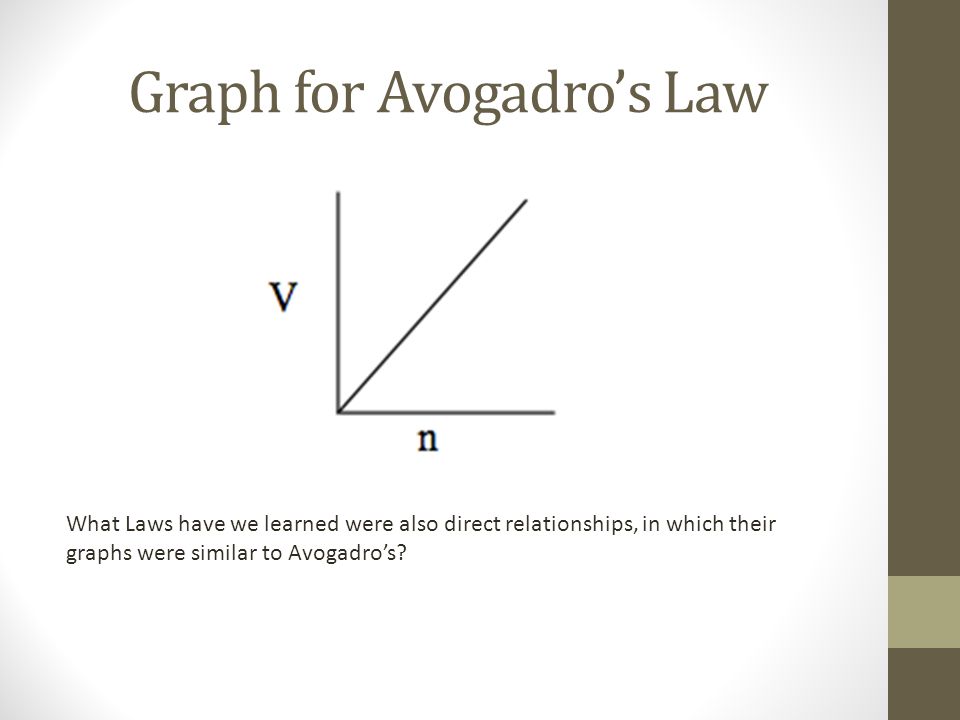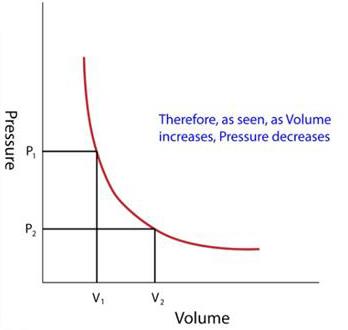Avogadro's law states that equal volumes of different gases contain an equal number of molecules. This applies when the temperature and pressure stay the same. Avogadro's law can be used to.
- Avogadro’s law, a statement that under the same conditions of temperature and pressure, equal volumes of different gases contain an equal number of molecules. This empirical relation can be derived from the kinetic theory of gases under the assumption of a perfect (ideal) gas.
- Using Avogadro's Law? Balanced equation. 2 F2 + 2 H2O - 4 HF + 1 O2. If the T and P are constant.
More Chemistry Lessons
Stoichiometry Lessons
In these lessons, we will learn the Molar Volume, Avogadro's Law, how to calculate gas volumes given moles and grams, how to calculate moles given gas volumes and how to calculate gas volumes given the chemical equation.
The molar volume is the volume occupied by one mole of a substance (chemical element or chemical compound) at a given temperature and pressure.
There are two standards, commonly used in schools:
- STP (standard temperature and pressure) which is 0° C and 1 atmosphere.
- RTP (room temperature and pressure) which is 25° C and 1 atmosphere.
Molar Volume
Avogadro’s Law states that:
1 mole of every gas occupies the same volume, at the same temperature and pressure.
At STP (standard temperature and pressure), this volume is 22.4 liters
At RTP (room temperature and pressure), this volume is 24 dm3 (liters)
We can also say:
The molar volume of a gas is 22.4 liters at STP (standard temperature and pressure).
The molar volume of gas is 24 dm3 at RTP (room temperature and pressure).
The following diagrams show how to convert between Mass, Moles and Gas Volumes. Scroll down the page for more examples and solutions.How to find the molar volume of a gas using the ideal gas law?
The most common molar volume is the molar volume of an ideal gas at standard temperature and pressure (273 K and 1.00 atm).
The molar volume is the volume occupied by 1 mol of a gas at standard temperature and pressure (STP). It can be calculated using PV = nRT.
Gas volumes from moles and grams
Example:
Calculate the volume of carbon dioxide gas, CO2, occupied by (a) 5 moles and (b) 0.5 moles of the gas occupied at STP.
Solution:
a) Volume of CO2= number of moles of CO2 × 22.4 L
= 5 × 22.4
= 112 L
 b) Volume of CO
b) Volume of CO 2
2= number of moles of CO2 × 22.4 L
= 0.5 × 22.4
= 11.2 L
How to convert from grams to moles to liters?
The following video shows an example of grams to moles to liters conversion.
It shows how to convert grams of a substance to liters at STP.
Example:
What is the volume of 5.643g of COs at STP?
Moles from Gas Volume
Example:
Calculate the number of moles of ammonia gas, NH3, in a volume of 80 L of the gas measured at STP.
Solution:
Volume of gas = number of moles × 22.414 L/mol
How to convert from liters to moles?
The following video shows an example of liters to moles conversion. It shows how to convert litres of a gas at STP into moles
Example:
How many moles are there in 60.2L of COs at STP?
- Show Step-by-step Solutions
Gas volumes from equations
From the equation for a reaction, we can tell how many moles of a gas take part. Using Avogadro’s Law, we can also work out its volume.
Example:
What volume of hydrogen will react with 22.4 liters of oxygen to form water? (All volumes are measured at STP)
Solution:
Step 1: Write a balanced equation for the reaction.2H2 (g) + O2 (g) → 2H2O (l)
Step 2: Calculate the volume.
From the equation, 2 volumes of hydrogen react with 1 of oxygen or
2 × 22.4 liters of hydrogen react with 22.4 liters of oxygen.
 The volume of hydrogen that will react is 44.8 liters.
The volume of hydrogen that will react is 44.8 liters. Example:
When sulfur burns in air it forms sulfur dioxide. What volume of this gas is produced when 1 g of sulfur burns? (Ar : S = 32) (All volumes are measured at STP)
Solution:
Step 1: Write a balanced equation for the reaction.S (s) + O2 (g) → SO2 (g)
Step 2: Get the number of moles from the grams.
32 g of sulfur atoms = 1 mole of sulfur atoms
So, 1 g = 1 ÷ 32 mole or 0.03125 moles of sulfur atoms
1 mole of sulfur atoms gives 1 mole of sulfur dioxide molecules
So, 0.03125 moles of sulfur atoms gives 0.03125 moles of sulfur dioxide
Step 3: Get the volume.
1 mole of sulfur dioxide molecules has a volume of 22.4 at STP
So, 0,03125 moles has a volume of 0.03125 × 22.4 = 0.7 liters at STP
So, 0.7 liters of sulfur dioxide are produced.
How to solve equation stoichiometry questions with gases?
Examples and practice problems of solving equation stoichiometry questions with gases. We calculate moles with 22.4 L at STP, and use molar mass (molecular weight) and mole ratios to figure out how many products or reactants we have.
Example:
How many grams of H2O will be produced by 58.2L of CH4 at STP? Assume an excess of O2. Examples and practice problems of solving equation stoichiometry questions with gases. We calculate moles with the Ideal Gas Law, because the conditions are not at STP, and use molar mass (molecular weight) and mole ratios to figure out how many products or reactants we have.
Example:
If 85.0 g of NaN3 decomposes at 75°C and 2.30 atm, what volume of N2 will be made?
- Show Step-by-step Solutions
Try the free Mathway calculator and problem solver below to practice various math topics. Try the given examples, or type in your own problem and check your answer with the step-by-step explanations.
We welcome your feedback, comments and questions about this site or page. Please submit your feedback or enquiries via our Feedback page.
Description
Avogadro’s law is an experimental gas law relating volume of a gas to the amount of substance of gas present. Avogadro’s law states that, “equal volumes of all gases, at the same temperature and pressure, have the same number of molecules”.
For a given mass of an ideal gas, the volume and amount (moles) of the gas are directly proportional if the temperature and pressure are constant.
his law explains how, under the same condition of temperature and pressure, equal volumes of all gases contain the same number of molecules. For comparing the same substance under two different sets of conditions, the law can be also expressed as V1/V2=n1/n2.
The equation shows that, as the number of moles of gas increases, the volume of the gas also increases in proportion. Similarly, if the number of moles of gas is decreased, then the volume also decreases. Thus, the number of molecules or atoms in a specific volume of ideal gas is independent of their size or the molar mass of the gas.
Variables
Using Avogadro's Law Aleks
| V1 | volume of the gas under conditions 1 (m3) |
| n1 | amount of the gas under conditions 1 (mol) |
| V2 | volume of the gas under conditions 2 (m3) |
| n2 | amount of the gas under conditions 2 (mol) |
Using Avogadro's Law Aleks
You must activate Javascript to use this site.
